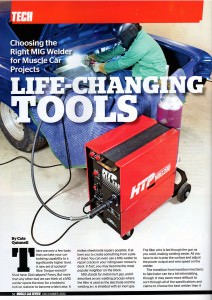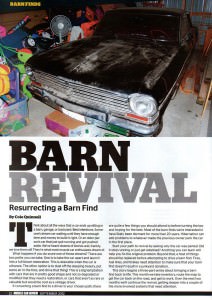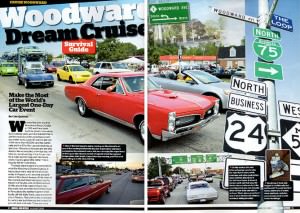
There are only a few tools you can add to your collection that can take your car-building capability to a significantly higher level. A new set of sockets –nice. Torque wrench – must have. Dial calipers – fancy. But the segment of tools we’re talking about here moves you from a bolt-on restorer to a fabricator:MIG welders.
More than any other tool we can think of, a MIG welder opens the door for a hobbyist car wrencher to become a fabricator. It makes sheetmetal repairs possible. It allows you to create something from a pile of steel. You can even use a MIG welder to repair cracks in your riding lawn mower’s deck. In fact, you may become the most popular neighbor on the block.

That first drive of a rescued barn find is like nothing else. It has the combined emotion of driving a new car for the first time, a rush down memory lane and the satisfaction of knowing you’ve put a classic muscle car back on the road. Unlike a complete restoration, the car will likely have some quirks that have accumulated naturally with age, and it will definitely have the look, feel and smell of an old car, not one of fresh paint and new interior components.
If you’ve followed this barn-find revival for the past two months, you already know that we’re showing the steps that will be typical in putting a car back on the road safely that’s been sitting for 20-plus years. The car we’re using for this series is a ’63 Chevy II. In addition to repairing decaying and d
Read More
Think about all the ways that a car ends up sitting in a barn, garage or backyard. Best intentions. Someone’s dream car waiting until they have enough time and money to build it right. Or an older person’s car that just quit running and got pushed aside. There are dozens of stories that we’ve heard and, frankly,we love them all! It’s what most muscle car enthusiasts dream of! A rare dual-quad Hemi car covered in an inch of dust and cobwebs, a 409 4-speed Impala hidden in a leaning garage next to an abandoned house or a 429 Galaxie doubling as a shelf in the back of a forgotten section of a warehouse.
What happens if you do score one of the dreams? There are two paths you can take. One is to take the car apart and launch into a full-blown restoration. Theother option is
Read More
We were there for the first Woodward Dream Cruise in 1995, and have been back for plenty more since. When you attend an event that has been the largest single-day car event in the world for more than 15 years, you better have a plan. It’s easy to get lost in the more than 40,000 cars that participate and the 1.5 million people strolling up and down Woodward Avenue, the side streets and checking out the same cars that you’re there to enjoy. And this compilation of insider’s tips will help you avoid waiting in line for an hour for a really bad hot dog and take home memories of a great time rather than a hospital bill for heat stroke.
The best place to start is to understand what the Woodward Dream Cruise is all about. The event takes place just north of Detroit every year
Read MoreThe undercarriage of a muscle car is something that no one looks forward to restoring. It’s not glorious work and no one admires the bottom of the floor plans like they do the topside paint, or the engine compartment or interior for that matter. And it can be downright difficult to do a decent job. But it’s also what sets a mediocre car apart from an extremely well done example.
As Tony Grzelakowski at Advanced Body and Color likes to say, “The paint quality follows the body work.” What that means is that the best paint job in the world only look as good as the body work below it. Getting the surface perfectly flat and blending in body work is where you should spend most of your time in prepping your muscle car for paint. That prep is made up of sheetmetal replacement, dent repair and block sanding. This article will give you the basics you’ll need to tackle dent repair.
While there are techniques to removing dents and waviness in metal panels, what is really required is patience. Unlike bolting on an intake manifold, there is not a step-by-step process is guaranteed to make a panel arrow straight. It takes practice and patience. Some areas may
Read MoreBetween bench racing at car shows and reading a little bit about paint chemicals, it’s pretty easy to become completely confused when it comes time to choose paint for our car. You’ll have people waxing on about the unmatched beauty of a hand-rubbed lacquer paint job offset by someone who loves the latest acrylic urethane two-stage system. Everyone has their favorite brand and line. Most of the literature you’ll find on automotive refinish products is written for professionals and environmental regulatory bodies. Oh, and paint is only one of about 10 products you’re going to need before all is said and done.
So we’ve put together this brief, um, primer, on paint chemicals. We used all PPG products on the car we show in this section, and we’ll stick with their produ
Read MoreIf you’re doing paint and body work on your muscle car, it’s a pretty safe bet that you’ll need to replace some sheet metal. Simply put, ifthe paint is questionable, the foundation under the paint is probably a bit shaky in at least a couple of spots. Rust has a way of workingbehind the scenes to eat holes in your precious car, and you may also uncover some previous repairs that it is now time to fix the right way.
There’s a plethora of reproduction sheetmetal available today, so it’s usually just a matter of realizing what you need to replace and then placing the order. Of course, new sheetmetal doesn’t fit old cars perfectly. Bolt on parts like fenders and doors need massaging to match your 45 year-old car, and weld-in parts need cutting and usually a little shap
Read MoreWe believe that you can have a nice looking car without completely stripping off all of the previous paint, primer and body filler. However, we think that the only way to do a thorough paint and body restoration is to strip the car to bare metal. Doing so exposes exactly whatyou are starting with and lets you address each issue the right way. The way that will keep problems from coming back two, five or 10 years later.
Muscle cars are 40-50 years old. There’s a lot of history hiding under whatever you see on the surface. And it’s the type of history that you need to permanently erase from your car if you want a durable, award-winning paint job.
The final yards of a paint job come once you have all of the sheet metal replacement work done, the dents are straightened and the body filler is sanded. But you’re still a bit away from the in zone. The last stages before paint are critical to executing a top-quality job that’s going to look great close up as well as far away, and last for years or decades to come.
In this final phase, we will cover block sanding. This is where the fingerprints will disappear from your hands and you’ll saturate your clothes with sanding dust. It’s also what makes the difference between a pretty straight car and an arrow-straight car. Block sanding uses layer of primers to fill in extremely small differences in height along the length of a body panel, and it may expose some spots that
Read More